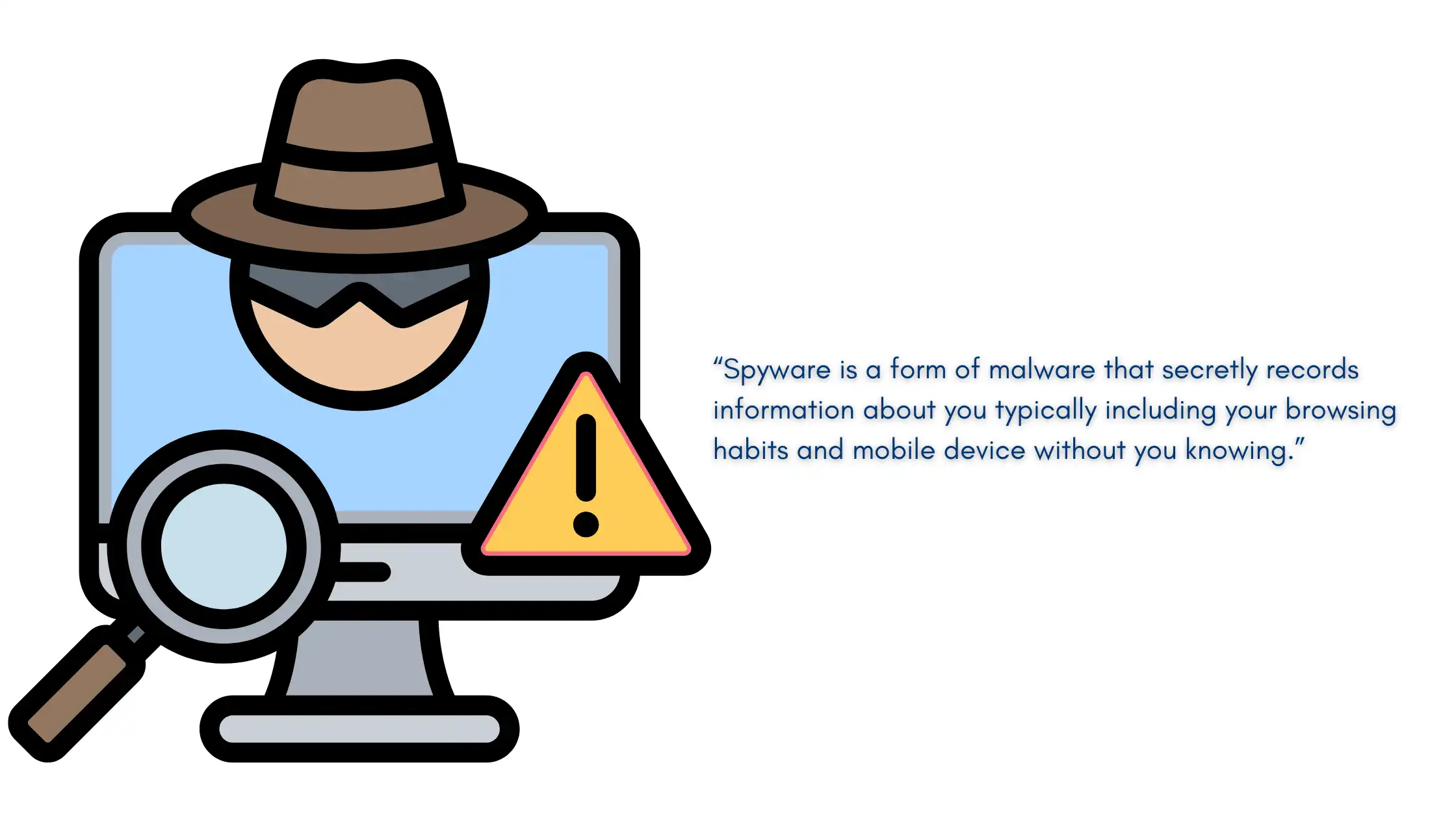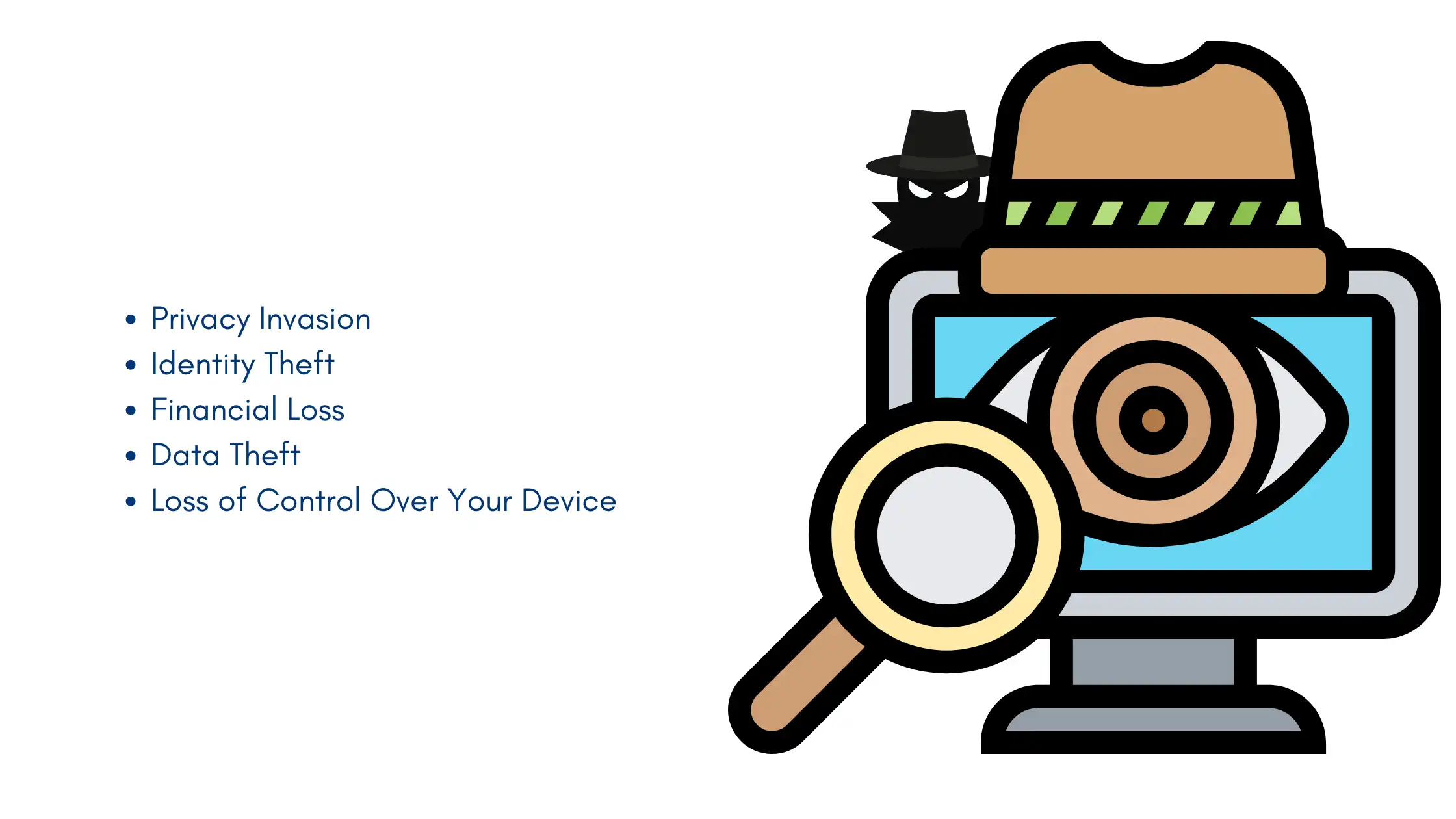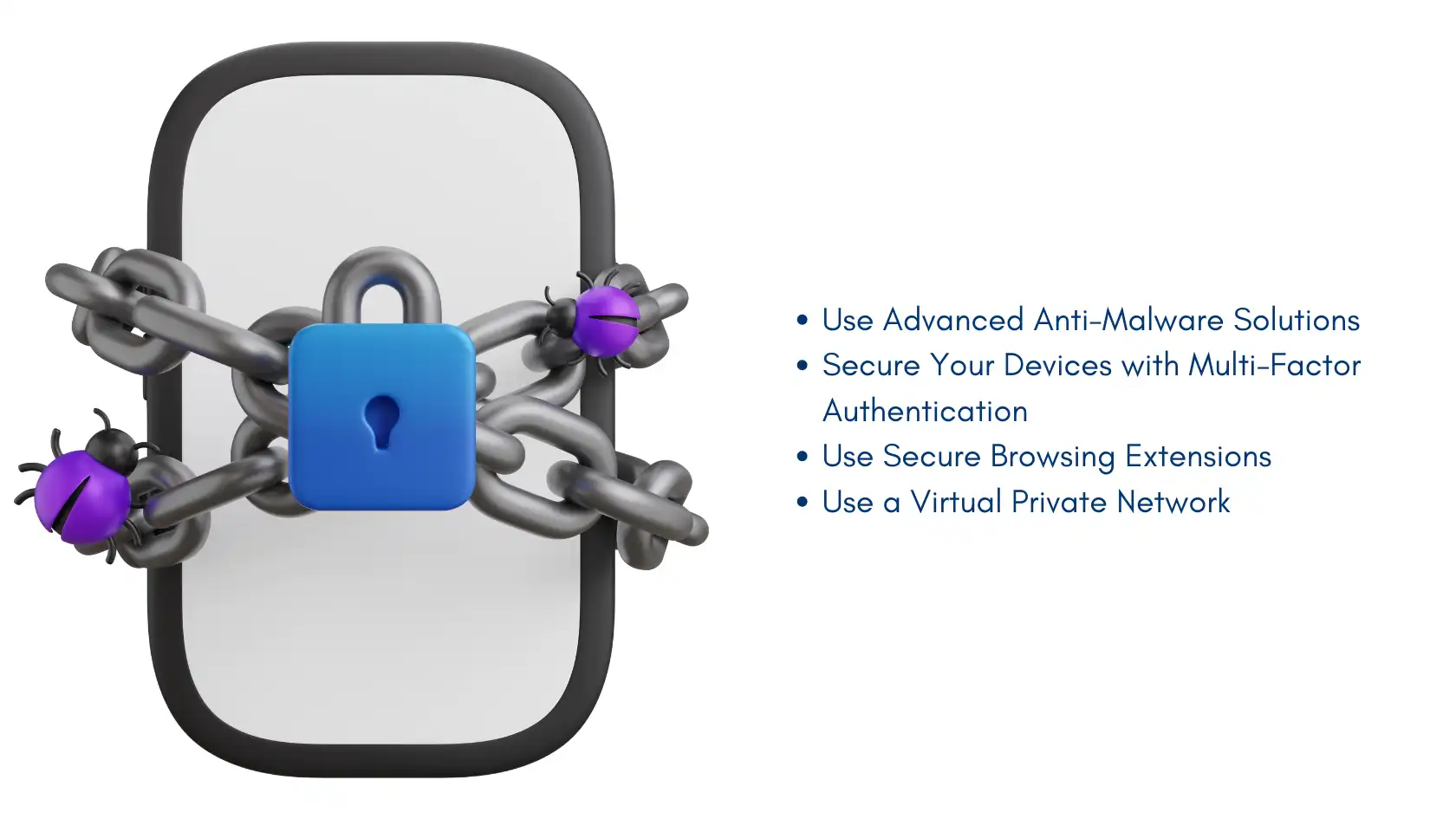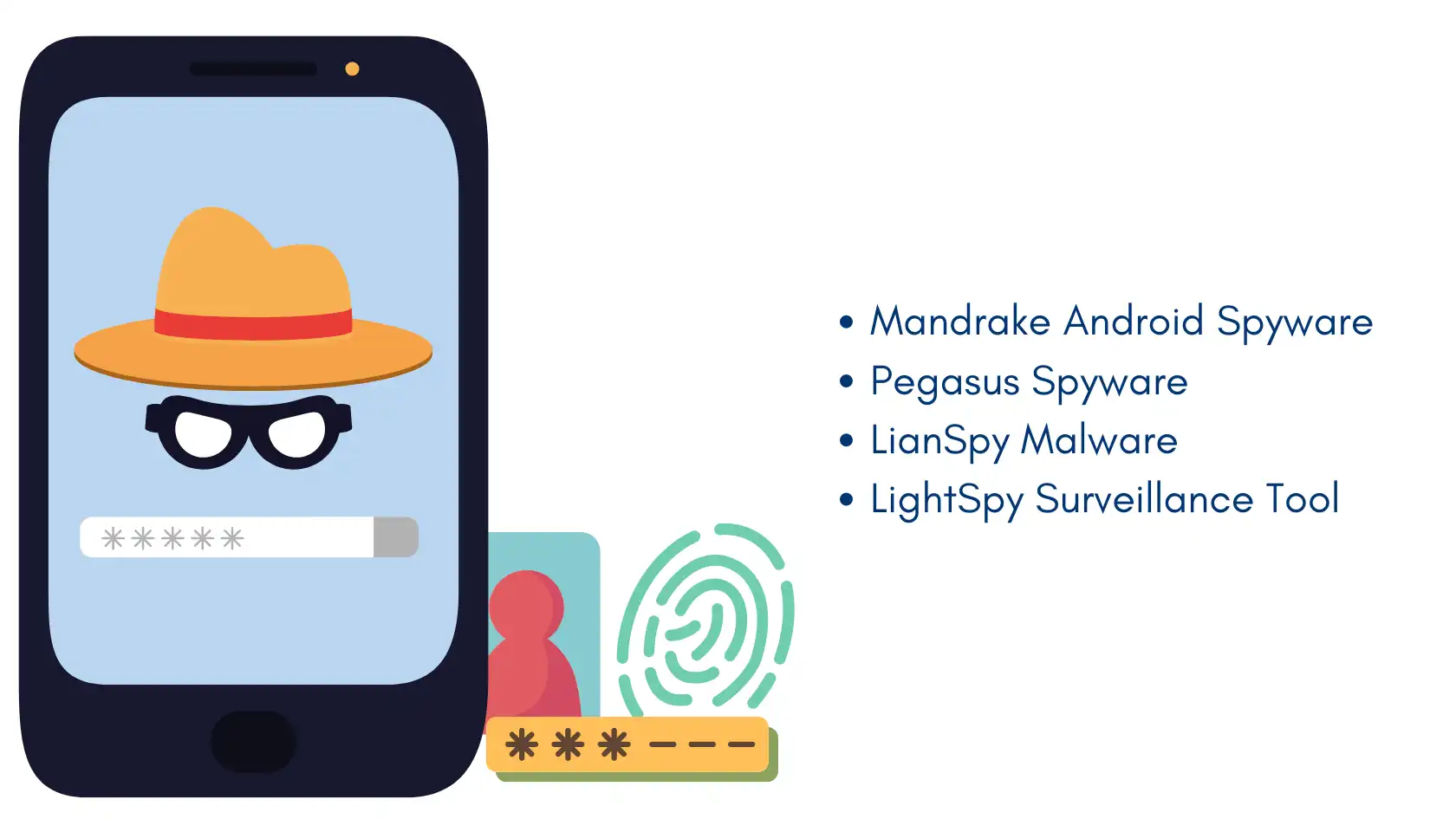How can I protect my device from spyware?” It is a question we all ask ourselves.
In this digital age, where our whole lives seem to be on our devices, the thought of someone secretly spying on us is pretty darn scary.
We have been fighting these digital varmints since before the Dark days of popup ads infiltrated our computer screens in the early millenniums, year 2000 to be exact.
It really just kind of feels like a ninja that can sneak into your home, steal all the passwords and take pictures while looking through your camera.
But don’t worry, we are not here to freak you out. We are here to arm you with the knowledge and tools to keep those digital spies at bay.
Ready to turn your device into a digital fortress? Stick around, because we are about to dive into the world of anti-spyware protection. Let us get started then.
What is Spyware?


- Lightning-fast speeds to browse without lag
- Servers in 105+ countries around the globe
- Military-grade security to stay safe online
- Try it risk-free with its money-back guarantee
- Native apps for all major devices
Spyware is a form of malware that secretly records information about you, typically including your browsing habits and mobile device, without you knowing.
In the background, it usually collects data like browser history and passwords as well as things more awful such as personal info and even financial information.
Implementing spyware protection is crucial as spyware can also be used to log your location, copy keystrokes, and take snapshots.
This information is normally sent to some third party so that they can use it in a variety of ways, from identity theft or for any unauthorized access to your accounts as well as targeted advertising.
Types of Spyware
There are several types of this software, each with different functions and it own purposes. Here is a breakdown of the types of spyware:
Adware
A type of spyware that gathers information about your internet surfing behavior and then gives you unwanted advertising.
Usually accompanying free programs, they are able to monitor the website you visit in order to deliver special offers.
Example: pop-up ads that open when you browse and take you to unwanted websites.
Keyloggers
A keylogger is a malware which automatically records keystrokes on your computer and extracts sensitive data such as passwords, credit card numbers or even messages. The attacker receives this data and can act upon it.
Example: A keylogger records every letter you write while signing in to your online banking account.
Trojans
Trojan spyware pretends to be a useful and legitimate program to trick you into installing it.
After installation, it allows hackers to remotely control your system.
This can involve theft of information or monetary assets, as well as sending further malicious malware out and taking over the device.
Example: A rogue antivirus that promises to eliminate the malware on your system, but instead installs spyware.
Tracking Cookies
While not inherently malicious, tracking cookies however can be used as spyware when they record and report your behaviors unseen by you.
With that data in hand, they can target ads or sell it to other parties.
Example: Cookies that track which websites you visit and what products you view, later giving you targeted ads based on that activity.
System Monitors
System monitors can record different types of data such as the emails containing conversations, instant messages and visits on websites.
They can be used by cybercriminals to harvest volumes of data from a target machine.
Example: A system monitor stealthily records every activity on your computer and sends it to another server.
Banking Trojans
Banking trojans are a particular type of spyware, aimed to steal financial data like online credentials for banking.
They often catch login information when you attempt to access your banking accounts.
Example: A Trojan is used to display a fake login screen at your online banking site, stealing the info and sending it off to some hacker somewhere.
Rootkits
A rootkit is a group of software that was used to keep malware including spyware, hidden from you.
They run at a very low level in the operating system that is difficult to find and remove.
Example: A rootkit hides a keylogger, which is not possible to identify by regular security solutions.
How Spyware Spreads
There are a number of ways spyware can infiltrate your computer or mobile device. It can spread in the form of:
Bundled Software
Spyware often comes bundled with free or pirated software. When you download and install these applications, spyware is installed along with them without your knowledge.
Malicious Websites
When you are visiting a compromised or a malicious website, it can result in an automatic download and installation of spyware onto your device.
This can happen through drive-by downloads, where simply visiting a website triggers the download of spyware without you doing anything.
Phishing Emails
The email attachments or links through phishing emails may contain spyware.
These emails are typically disguised as if they were from a trustworthy source, with the purpose of getting you to download an associated attachment or click on the provided link, leading you to where the spyware is installed.
Make sure to prevent phishing attacks by being cautious about unexpected emails, even if they appear to be from a reliable source.
Fake Software Updates
But then also those malware authors create some pop ups which pretend to be real update messages.
The pop-ups are fake since spyware will be installed on computers instead of an update when users click the links.
Social Engineering
Spyware can be used to deceive you through social engineering in convincing you to download and install it in the device. These fake alerts can tell you that your system has infections or that your device is at risk.
Removable Media
Spyware may come into your system via infected USB drives, CDs or other removable media as well. It downloads the spyware and installs automatically as soon as the media is accessed.
Exploit Kits
An exploit kit is a convenient tool for cybercriminals to make use of when exploiting software or operating system weaknesses.
Using these security holes, exploit kits are able to inject spyware onto your device if you visit an infected website.
How Spyware Can Affect You?

Spyware can have significant negative impacts on both, users and organizations. Here is how it can affect you:
Privacy Invasion
Spyware records your online activity, what pages did you open, which content was downloaded and inquired about.
As a user, you should not be responsible for providing this data which can then sell to advertisers or use it as the base of adding their targeted adverts.
Identity Theft
Spyware can result in identity theft because the information it captures includes usernames, passwords, social security numbers, and credit card details.
The use of strong passwords is essential, as the details that spyware gives out can enable cybercrooks to do a lot of damage, such as opening bank accounts or applying for credit cards in your name.
Financial Loss
Banking Trojans and keyloggers fall under the category of spyware which are created to capture your financial information.
They can record your online banking login details, which is then used to compromise your bank accounts for the purpose of fraudulent transactions and financial loss.
System Performance Issues
Your device could suffer at a performance level with spyware, as it likes to consume system resources and ultimately will slowdown your speed or crash continuously.
It can also make your internet slow down by sending information to remote servers.
Data Theft
It accesses confidential files, documents and all of the personal data on your device.
This personal information can then be used in threats for blackmail, to sell on the dark web or just simply damage your reputation.
Reduced Security
Rootkits help other types of malware to bypass standard security protocols and compromise your device even further. This leads to more infections and compromises on the system.
Unwanted Ads and Pop-ups
Adware, advertisements are developed by this form of spyware and the ads it generates can be particularly disturbing.
These ads can also direct you to other malware infections, especially if you click them.
Loss of Control Over Your Device
With spyware, an attacker can remotely gain access to your device. They will be able to control it themselves and perform any action like installing more malware or organizing pool attacks on other systems.

Uninterrupted, high-speed browsing, zero logs so your online activity is always private.
Over 7000 people checked out NordVPN in the last month
How To Protect Against Spyware?

Stopping spyware is a compound of steps such as knowing how to prevent spyware, using the latest technology available, and adopting good security habits.
Keep reading to find out what the most effective techniques are for how you could safeguard yourself against spyware.
Use Advanced Anti-Malware Solutions
- Behavior-Based Detection: Instead of relying only on signature-based detection which looks for known threats, it use anti-malware solutions that include behavior-based detection. This technology looks for any suspicious activities that might indicate a spyware, even if it has not been previously identified.
- AI-Powered Security: Latest real-time anti-virus programs use AI and Machine Learning to identify viruses and containment threats more efficiently. They are able to adjust for the latest spyware when it appears.
Secure Your Devices with Multi-Factor Authentication
With MFA, you are adding another layer of protection by requiring more, a password alone is not enough to access your accounts.
Even if spyware steals your credentials, the attacker won’t be able to log in without the second factor like a fingerprint, face recognition or a code which is sent to your phone.
Use Secure Browsing Extensions
- Privacy-Focused Browsing Extensions: Use privacy-focused browsing extensions for blocking malicious scripts, trackers and ads that may install spyware. Extensions like HTTPS Everywhere, Privacy Badger or uBlock Origin.
- Anti-Phishing Tools: These are meant to detect and block phishing sites, whose aim is to lure you into downloading spyware.
Keep Your Software and Operating System Up to Date
- Automatic Updates: Allow automatic updating of your OS and applications to make sure that you receive the latest security updates.
- Zero-Day Protection: Few modern security tools are equipped with Zero-day protection which does not allow your device to be targeted by even the most recent exploits that have yet to get fixed.
Use a Virtual Private Network
VPN adds reinforcements to prevent spyware by encrypting your internet traffic.
Any sensitive data like passwords or financial information can’t be intercepted and used for malicious purposes.
When you connect to the web with a VPN, your public IP address is hidden, preventing online spyware from monitoring or tracking you.
When using public Wi-Fi, your VPN ensures the security of your connection, helping you keep your connection safe on public Wi-Fi and reducing the chance of installing spyware through these networks.
However, a VPN, despite being a powerful privacy and security tool in its own right, cannot eliminate spyware already lurking on your device.
Employ Application Sandboxing
- Isolated Environment: An OS feature that allows application to run in a sandbox so if the potentially risky application crashed, there would be no impact on other applications running within your device. This makes sure that, in case the application is compromised, it will not affect the rest of your system from spyware.
Enable Enhanced Privacy Features
- Web Browser Privacy Settings: Configure your browser to disable third-party cookies and trackers. Use privacy-focussed browsers like Brave or Firefox with increased tracking protection.
- Operating System Privacy Tools: Limit the permissions in your OS to access like camera, microphone and location privileges.
Monitor and Control App Permissions
- Review Permissions Regularly: Regularly review and limit the permissions which are granted to apps on your devices. For example, a flashlight app should not need to access your contacts or camera.
- Permission Manager Tools: Use permission manager tools or apps to get notifications when an app requests sensitive permissions.
Implement Endpoint Detection and Response (EDR)
- Continuous Monitoring: EDR solutions continuously protects your device and can automatically respond to threats so the team is able to get alerted and take measures as required. It is also important for detecting and removing spyware that was allowed through the initial line of defense.
Adopt a Zero-Trust Security Model
- Least Privilege Access: Implement a zero-trust security model meaning make sure that users and devices are only given access to what they really need. It provides a protective barrier to the nature of spyware and reduces the harm done if your device falls under its influence.
- Micro-Segmentation: Create an isolated network section that separates its workspace from the rest of your network, reducing the spread of spyware across your network.
Use Hardware Security Modules (HSM)
- Secure Key Storage: It securely creates, store and manages the cryptographic keys in HSMs and guarantee that no spyware can read it even if the complete system has been compromised.
Back-Up Your Data Regularly
- Automated Backups: Better use automated cloud backups or offline machine based copies to save yourself from data corruption even if spyware is wanting to steal your precious important information. You must test these backups on a regular basis to make sure that they can indeed be restored properly.
Use Encrypted Storage Devices
- Full Disk Encryption: Use full disk encryption to keep your device data safe from spyware in the event of loss or theft.
- Encrypted USB Drives: Use encrypted USB drives to store sensitive data which can prevent any unauthorised access in case your drive gets infected with spyware.
By combining these modern methods with traditional security strategies, you will be reducing the risk of getting an infected spyware and keeping your personal as well financial information from unauthorized access.
Recent Spyware Attacks

The risk to privacy and security would seem to be a global concern based on just some of the more high-profile spyware attacks in recent weeks. The following are some of the recent examples:
Mandrake Android Spyware
The Mandrake has appeared from over the road on five Android applications that have been downloaded 32,000 times in total.
This makes it an extremely dangerous piece of spyware too, since full control over a compromised device lets attackers view encrypted emails and messages in browser windows or even take screenshots.
They can also open URLs using web overlays that appear as though the user started them. The malware was time-bombed to lie undercover for months before activating, further complicating detection efforts.
Pegasus Spyware
Pegasus spyware was made by NSO Group. New evidence shows that Pegasus employed new zero-click exploits to infect Apple device users worldwide, including some in civil society in Mexico.
Named PWNYOURHOME and FINDMYPWN, the exploits used HomeKit or iMessage to remotely hack a device without requiring user action.
Apple closed down the security flaws that allowed FlexiSpy to slip past standard iOS safety, but for a while there it was being able to go undetected and hack into iPhones.
LianSpy Malware
Another recent discovery is the LianSpy malware which is targeting Russian Android users.
LianSpy also appears to stops Android’s security features and thus bypassing the OS detection.
It is a type of malware that can collect and send many personal data present on the hosts which are infected.
LightSpy Surveillance Tool
The LightSpy malware that has in the past been seen affecting Android and iOS now appears to target macOS too.
It is a powerful surveillance tool with strong links to state-sponsored attacks, used in large scale against activists.
These incidents serve as a reminder to update your device with the latest security patches and beware of which apps you install, even from official app stores.
Although take measures like using VPNs, anti-malware software and enabling Apple’s Lockdown Mode can offer additional layers of protection against these more sophisticated threats.
FAQs
What can be done to prevent spyware?
How do you defend against spyware?
What is the best way to avoid getting spyware on a machine?
What is designed to prevent and remove spyware?
Can you block spyware?
How do I remove spyware from my device?
Conclusion
We have covered a lot of ground in our battle against spyware.
From sneaky keyloggers to those persistent tracking cookies, we have shone a light on the dark corners where spyware likes to hide.
Protecting against spyware is not a one-and-done deal. It is more like an ongoing process where we need to stay on our toes and keep up with the latest moves.
With the tools and tricks we have shared, you are now equipped to lead that process.
It is not about being paranoid. It is about being smart and proactive.
Keep your software updated, be cautious about what you click on and use those security tools we talked about.
Now you are ready to go out there and defend your digital realm.
So, the next time you are browsing the web, downloading an ap or just checking your email, take a moment to think about your digital safety.
After all, in this connected world, we are all in this together. Stay safe out there and happy browsing.






